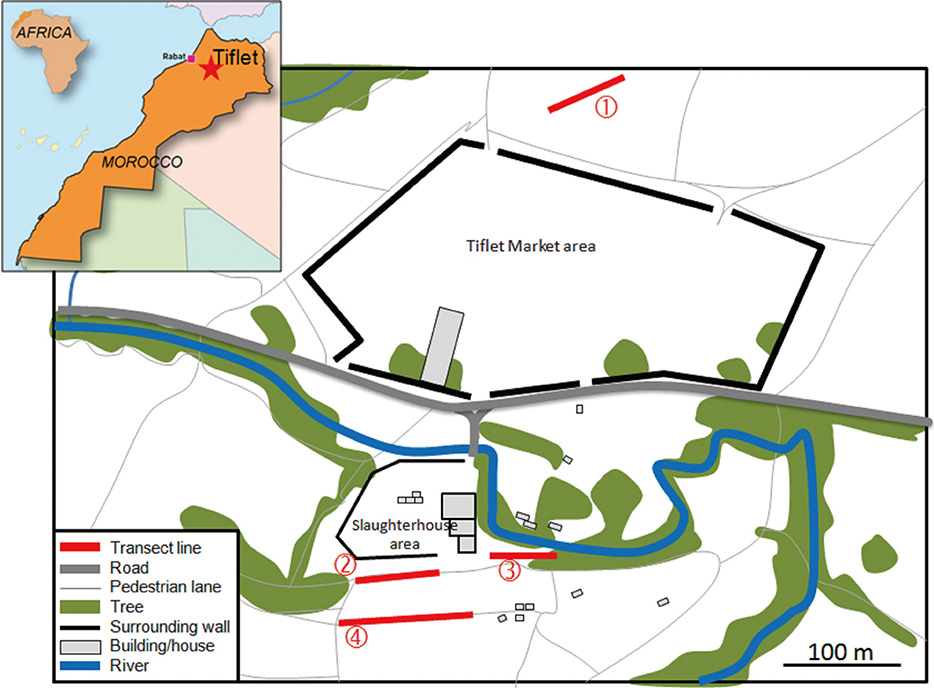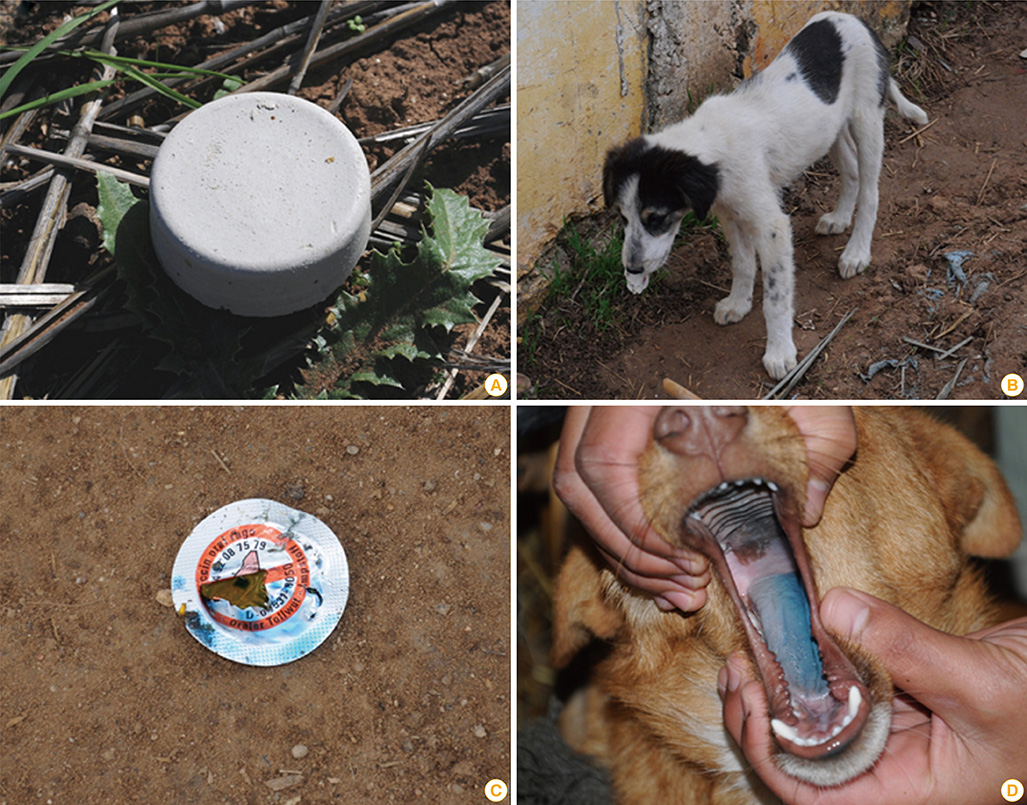Clin Exp Vaccine Res.
2014 Jul;3(2):220-226. 10.7774/cevr.2014.3.2.220.
First trials of oral vaccination with rabies SAG2 dog baits in Morocco
- Affiliations
-
- 1Moroccan Office for Food Safety (ONSSA), Division of Pharmacy and Veterinary Inputs, Rue Ikhlass, Cite Yacoub El Mansour, Rabat, Morocco. darkaouisami@gmail.com
- 2French Agency for Food, Environmental and Occupational Health and Safety (ANSES), Nancy Laboratory for Rabies and Wildlife, WHO Collaborating Centre for Research and Management in Zoonoses Control, OIE Reference Laboratory for Rabies, European Union Refer
- 3Agronomic and Veterinary Institute Hassan II, Unit of Microbiology, Immunology and Contagious Diseases, Department of Pathology and Veterinary Public Health, Rabat-Instituts, Rabat, Morocco.
- KMID: 1730627
- DOI: http://doi.org/10.7774/cevr.2014.3.2.220
Abstract
- PURPOSE
Canine rabies is a serious health problem in Morocco and about 22 human deaths are reported yearly. Following the World Health Organization (WHO) recommendations, Moroccan authorities evaluated oral rabies vaccine baits specially designed for dogs.
MATERIALS AND METHODS
The study was performed in Tiflet area. The vaccine strain was SAG2, a modified live oral rabies vaccine strain. Each bait contained an aluminium/PVC capsule filled with a liquid. Two kinds of baits were used: placebo baits containing methylene blue as a topical marker and vaccine baits containing vaccine suspension. The study was performed according to recommended WHO strategies, i.e., door to door model (DDDM), hand-out and wildlife immunization model (WIM). The DDDM was performed in the rural area of Tiflet on 60 owned dogs. The hand-out strategy was tested on 15 stray dogs. The WIM was performed on 4 transects lines near Tiflet slaughterhouse and near the weekly traditional market location.
RESULTS
Using the DDDM, 100% of owned dogs were attracted by the baits and 77% ate the bait. Using the hand-out model, 100% of dogs showed interest in baits and 46.7% took the baits. Using the WIM in stray dogs, up to 73% of baits disappeared and 68% of the capsules containing the SAG2 vaccine were found pierced, depending on the sites of distribution.
CONCLUSION
This pilot study showed that baits have a good palatability and that oral vaccination of both owned and stray dogs is feasible with baits specifically developed for dogs and with adapted strategy of distribution.
Keyword
MeSH Terms
Figure
Cited by 1 articles
-
Immunogenicity and efficacy of Rabivac vaccine for animal rabies control in Morocco
Sami Darkaoui, Ouafaa Fassi Fihri, Jean Luc Schereffer, Nadia Aboulfidaa, Marine Wasniewski, Karima Zouine, Mohammed Bouslikhane, Khadija Id Sidi Yahia, Florence Cliquet
Clin Exp Vaccine Res. 2016;5(1):60-69. doi: 10.7774/cevr.2016.5.1.60.
Reference
-
1. Nel LH. Discrepancies in data reporting for rabies, Africa. Emerg Infect Dis. 2013; 19:529–533.
Article2. Knobel DL, Cleaveland S, Coleman PG, et al. Re-evaluating the burden of rabies in Africa and Asia. Bull World Health Organ. 2005; 83:360–368.3. World Organization for Animal Health. Stray dog population control. Terrestrial animal health code. Paris: World Organization for Animal Health;2012.4. Schneider MC, Belotto A, Ade MP, et al. Current status of human rabies transmitted by dogs in Latin America. Cad Saude Publica. 2007; 23:2049–2063.
Article5. El Harrak M. Epidemiological factors and control of rabies in North Africa. In : Compendium of the OIE Global Conference on Rabies Control; 2011 Sep 7-9; Incheon, Korea. Paris: World Organization for Animal Health;2012. p. 45–49.6. World Organization for Animal Health. Terrestrial Animal Health Code. General provisions. Paris: World Organization for Animal Health;2013.7. Fassi-Fihri O. Historique et situation épidémiologique de la rage au Maroc. Renforcement de la surveillance et des systèmes d'alerte pour la fièvre catarrhale ovine, la fièvre du Nil occidental et la rage au Maroc, en Algérie et en Tunisie. Projet FAO GCP/RAB/002/FRA. Rome: Food and Agriculture Organization of the United Nations;2008.8. Yang DK, Kim HH, Lee KW, Song JY. The present and future of rabies vaccine in animals. Clin Exp Vaccine Res. 2013; 2:19–25.
Article9. Rosatte RC, Power MJ, Donovan D, et al. Elimination of arctic variant rabies in red foxes, metropolitan Toronto. Emerg Infect Dis. 2007; 13:25–27.
Article10. Rosatte R, MacDonald E, Sobey K, et al. The elimination of raccoon rabies from Wolfe Island, Ontario: animal density and movements. J Wildl Dis. 2007; 43:242–250.
Article11. World Health Organization. Oral vaccination of dogs against rabies. Guidance for research on oral rabies vaccines and field application of oral vaccination of dogs against rabies. Geneva: World Health Organization;2007.12. World Health Organization. WHO expert consultation on rabies. Second report WHO technical report series. No. 982. Geneva: World Health Organization;2013.13. Zouine K, Ezzahra Lahkak F, Demerson JM, et al. La rage au Maroc: situation, perspectives de lutte, faisabilité de la vaccination orale des chiens contre la rage. In : Troisièmes Rencontres du Bureau des Experts de la Rage du Continent Africain (AfroREB); 2011 May 23-26; Casablanca, Maroc.14. Lafay F, Benejean J, Tuffereau C, Flamand A, Coulon P. Vaccination against rabies: construction and characterization of SAG2, a double avirulent derivative of SADBern. Vaccine. 1994; 12:317–320.
Article15. Cliquet F, Guiot AL, Munier M, Bailly J, Rupprecht CE, Barrat J. Safety and efficacy of the oral rabies vaccine SAG2 in raccoon dogs. Vaccine. 2006; 24:4386–4392.
Article16. Cliquet F, Gurbuxani JP, Pradhan HK, et al. The safety and efficacy of the oral rabies vaccine SAG2 in Indian stray dogs. Vaccine. 2007; 25:3409–3418.
Article17. Schumacher CL, Coulon P, Lafay F, et al. SAG-2 oral rabies vaccine. Onderstepoort J Vet Res. 1993; 60:459–462.18. Bingham J, Schumacher CL, Aubert MF, Hill FW, Aubert A. Innocuity studies of SAG-2 oral rabies vaccine in various Zimbabwean wild non-target species. Vaccine. 1997; 15:937–943.
Article19. Follmann EH, Ritter DG, Baer GM. Evaluation of the safety of two attenuated oral rabies vaccines, SAG1 and SAG2, in six Arctic mammals. Vaccine. 1996; 14:270–273.
Article20. Masson E, Cliquet F, Aubert M, et al. Safety study of the SAG2 rabies virus mutant in several non-target species with a view to its future use for the immunization of foxes in Europe. Vaccine. 1996; 14:1506–1510.
Article21. Follmann EH, Ritter DG, Hartbauer DW. Safety of lyophilized SAG2 oral rabies vaccine in collared lemmings. J Wildl Dis. 2002; 38:216–218.
Article22. Hammami S, Schumacher CL, Cliquet F, et al. Safety evaluation of the SAG2 rabies virus mutant in Tunisian dogs and several non-target species. Vet Res. 1999; 30:353–362.23. Cliquet F, Aubert M. Elimination of terrestrial rabies in Western European countries. Dev Biol (Basel). 2004; 119:185–204.24. Frontini MG, Fishbein DB, Garza Ramos J, et al. A field evaluation in Mexico of four baits for oral rabies vaccination of dogs. Am J Trop Med Hyg. 1992; 47:310–316.
Article25. Schumacher CL, Hammami S, Chaparro F, et al. Safety of the oral rabies vaccine SAG2 and efficacy of its delivery system DBL2 in indigenous dogs. In : Proceedings of the Southern and Eastern African Rabies Group (SEARG) Meeting; 1997 Mar 4-6; Nairobi, Kenya. p. 163–174.26. Faizah , Mantik-Astawa IN, Putra AA, Suwarno . The humoral immunity response of dog vaccinated with oral SAG2 and parenteral Rabisin and Rabivet Supra92. Indones J Biomed Sci. 2012; 6:26–29.27. Ben Youssef S, Matter HC, Schumacher CL, et al. Field evaluation of a dog owner, participation-based, bait delivery system for the oral immunization of dogs against rabies in Tunisia. Am J Trop Med Hyg. 1998; 58:835–845.
Article28. World Health Organization. WHO expert consultation on rabies, 1st report. WHO Technical Report Series 931. Geneva: World Health Organization;2005.29. World Health Organization. WHO expert committee on rabies, 8th report. WHO Technical Report Series 824. Geneva: World Health Organization;1992.30. van Heerden J, Bingham J, van Vuuren M, Burroughs RE, Stylianides E. Clinical and serological response of wild dogs (Lycaon pictus) to vaccination against canine distemper, canine parvovirus infection and rabies. J S Afr Vet Assoc. 2002; 73:8–12.
Article31. Lambot M, Blasco E, Barrat J, et al. Humoral and cell-mediated immune responses of foxes (Vulpes vulpes) after experimental primary and secondary oral vaccination using SAG2 and V-RG vaccines. Vaccine. 2001; 19:1827–1835.
Article32. Bingham J, Schumacher CL, Hill FW, Aubert A. Efficacy of SAG-2 oral rabies vaccine in two species of jackal (Canis adustus and Canis mesomelas). Vaccine. 1999; 17:551–558.
Article33. Follmann EH, Ritter DG, Donald WH. Oral vaccination of captive arctic foxes with lyophilized SAG2 rabies vaccine. J Wildl Dis. 2004; 40:328–334.
Article34. Hanlon CA, Niezgoda M, Morrill P, Rupprecht CE. Oral efficacy of an attenuated rabies virus vaccine in skunks and raccoons. J Wildl Dis. 2002; 38:420–427.
Article35. Corn JL, Mendez JR, Catalan EE. Evaluation of baits for delivery of oral rabies vaccine to dogs in Guatemala. Am J Trop Med Hyg. 2003; 69:155–158.
Article36. Linhart SB, Baer GM, Balderas Torres JM, et al. Acceptance of candidate baits by domestic dogs for delivery of oral rabies vaccines. Onderstepoort J Vet Res. 1997; 64:115–124.37. Bergman D, Bender S, Wenning K, et al. Bait acceptability for delivery of oral rabies vaccine to free-ranging dogs on the Navajo and Hopi Nations. Dev Biol (Basel). 2008; 131:145–150.38. Matter HC, Schumacher CL, Kharmachi H, et al. Field evaluation of two bait delivery systems for the oral immunization of dogs against rabies in Tunisia. Vaccine. 1998; 16:657–665.
Article39. Bishop GC. Increasing dog vaccination coverage in South Africa: is oral vaccination the answer?. In : Dodet B, Meslin FX, editors. Rabies control in Asia. London: John Libbey & Sons, Ltd.;2001. p. 105–109.40. Zinsstag J. Towards a science of rabies elimination. Infect Dis Poverty. 2013; 2:22.
Article
- Full Text Links
- Actions
-
Cited
- CITED
-
- Close
- Share
- Similar articles
-
- Immunogenicity and efficacy of Rabivac vaccine for animal rabies control in Morocco
- Outbreaks and Control of Animal Rabies in Korea
- Rabies Outbreaks and Control during the Japanese Colonial Period in Korea
- The Politics of Breeding: Rabies Prevention and the Shaping of Human–Dog Relations in Modern Japan
- General Features and Post-Exposure Prophylaxis of Rabies



